![]()
![]()
![]()
Use LEFT and RIGHT arrow keys to navigate between flashcards;
Use UP and DOWN arrow keys to flip the card;
H to show hint;
A reads text to speech;
14 Cards in this Set
- Front
- Back
- 3rd side (hint)
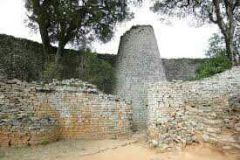
|
N. Conical Tower and Circular Wall of Great Zimbabwe D. 1000-1400 CE P/S. 11th century A. Shona Peoples OL. Southeastern Zimbabwe P. N/A M/T. Coursed Granite Blocks F. DT. Also known as the Great Enclosure. 36 feet High and approximately 820 feet wide. All of Great Zimbabwe’s walls were fitted without the use of mortar by laying stones one on top of the other, walls were fitted together closely and evenly. C. 1,800 acres of present-day southeastern Zimbabwe. expanded for more than 300 years. largest ancient structure south of the Sahara Desert. |
|
|
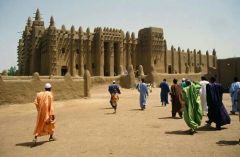
|
N. Great Mosque of Djenné D. Founded c. 1200 CE ; Rebuilt 1906-1907 CE P/S. 11th century A. Malí people OL. Mali, Africa P. N/A M/T. Adobe. Made of mud brick F. Religious practice place DT. covered with clay plaster that gives the building a sleek, sculptural appearance. thickness varies depending on the height of the wall. Inside, the mosque has several large halls and numerous corridors, separated by columns. The entire complex is built on a 75X75 meter platform that is raised three meters above ground C. greatest achievement of Sudano-Sahelian architecture. largest mud-built structure in the world. center of commerce, learning, and Islam. one of the most famous landmarks in Africa. |
|
|

|
N. Wall Plaque, from Oba's Palace D. 16th Century CE P/S. 16th century African A. Edo Peoples OL. Benin (Nigeria) P. N/A M/T. Cast Brass F. show how the people of Benin perceived the Portuguese traders DT. pointed noses, thin faces and beards and strange clothes. C. have been made in matching pairs and fixed to pillars. Portuguese were regarded as symbols of the king’s wealth and power, Oba was the spiritual, secular and ritual head of the kingdom, considered a deity and held in the highest veneration |
|
|
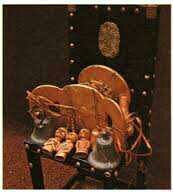
|
N. Sika Dwa Kofi (Golden Stool) D. 1700 CE P/S. 18th century A. Ashanti Peoples OL. South Central Ghana P. N/A M/T. Gold Over Wood and Cast-Gold Attachments F. houses the soul of the Asante nation and is the supreme symbol of the kingdom. DT. It is carved from one solid piece of hardwood, completely covered in gold. There are a couple solid gold bells and a few solid gold human figurines. The human figurines represent some defeated enemies. They are also meant to remind the Asante people of the story of the stool's origin. C. “Golden Stool was said to have been delivered from the sky by the priest Okomfo Anokye to land on the knees of the first Asantehene". when the British came to the kingdom and fought the Asante over the golden stool and power over that land |
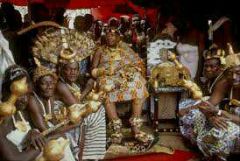
|
|
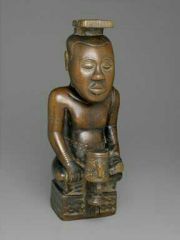
|
N. Ndop (Portrait Figure) of King Mishe miShyaang maMbul D. 1760-1780 CE P/S. 18th century A. Kuba Peoples OL. Democratic Republic of the Congo P. King Mishe M/T. Wood F. created to preserve their legacy. DT. They are all sitting cross-legged with a calm facial expression, closed eyes and the same sort of headpiece. Knife shows his ability to understand and be peaceful. The head is thought of as the seed of intelligence and he must be portrayed as very smart C. Each new king creates his own personal emblem and is placed on the ndop. They all have different things placed in front of them. |
|
|
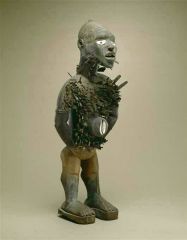
|
N. Power Figure (Nkisi n'kondi) D. Late 19th to Early 20th Century CE P/S. 19th Century A. Chokwe Peoples OL. Democratic Republic of the Congo P. N/A M/T. Wood and Metal F. It embodies an ancestral spirit who will hunt down sources of misery and destroy them and hunt down anyone who has taken a vow, oath or contract and who hasn't kept that promise. DT. man bristling with nails and blades. Hands akimbo with feet spread apart and chin jutting out with eyes big and wide and mouth open. Has massive, strong shoulders and is wearing a beaded hat for a chief to show power and authority. It is an intimidating powerful and moral force C. Nkisi n'kondi means, Spirit hunter. things they would put inside the cavity or spread on top of the Nkisi n'kondi where Magical substances or herbs as medicine. Also metaphorical qualities for speed, velocity, et |
|
|
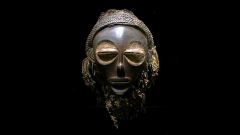
|
N. Female (Pwo) Mask D. Late 19th to Early 20th Century CE P/S. African A. Chokwe People OL. Democratic Republic of the Congo P. Unknown M/T. Wood, fiber, pigment, and metal F. Ceremonials, rituals, dances DT. has a broad forehead, completely round eye sockets with almond eyes that are almost closed,glowing reddish brown surface to represent healthy skin, delicate nose and ears, almost closed mouth, brownish red hair that comes from putting clay in ones hair C. it is danced during male initiation rites to show young boys what they should be looking for in their wives. represents Pwo who represents fertility so when the mask is danced it is thought to bring fertility to future generations |
|
|
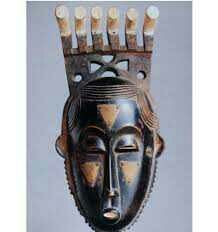
|
N. Portrait mask (Mblo) D. Early 20th Century P/S. African A. Baule Peoples (Côte d'Ivoire) OL. Democratic Republic of Kongo P. Unknown M/T. Wood and pigment F. used during mblo dance DT. masks represent individuals idealized. Her eyes, while closed, are covered in kaolin to make the surrounding area white, and it is connected to the spiritual realm, which implies a kind of second sight, rather than solely seeing the physical world. C. only the best dancers can dance as it is used to please the spirits. always worn by a man who is disguised as a woman with a bodysuit. During the performance, the Mwana Pwo dancer mimics and exaggerates the mannerisms of young Chokwe women. Only the best dancers in the village would be allowed to participate in the mblo |
|
|
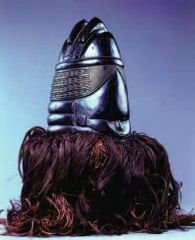
|
N. Bundu Mask D. 19th to 20th Century CE P/S. African A. Sande Society, Mende Peoples OL. West African Forest of Sierra Leone and Liberia P. Elders of the family M/T. Wood, cloth, and fiber F. Ceremonial DT. Full forehead means wisdom, intelligence; downcast eyes means modesty; neck rings means health and prosperity birds means messengers between spirits and humans; white cloth means ritual purity; antelope horns represent good medicine C.this mask is worn during the ceremony when young girls are taken from their homes into the forest. young girls taught how to be a mother and woman, and the societal expectations for women |
|
|
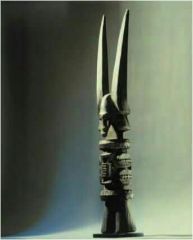
|
N. Ikenga (Shrine Figure) D. 19th to 20th Century CE P/S. African A. Igbo Peoples OL. Nigeria P. Luba Royalty M/T. Wood F. For private use DT. personal shrine reflects the great value the Igbo place on individual achievement. the right hand holds the hoe, the sword, and the tools of craftsmanship. The basic form of an ikenga is a human figure with horns symbolizing power. C. to honor the power and skills of a person's right hand. |
|
|
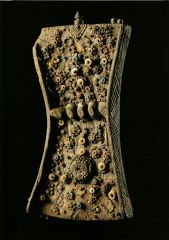
|
N. Lukasa (Memory Board) D. 19th to 20th Century P/S. African A. Mbudye Society,Luba Peoples OL. Democratic Republic of the Congo P. Lube elders M/T. Wood, beads, and metal F. keep alive the memory of the history of the Luba people. They tell actual events, creation stories, and important beliefs or values. DT. As they tell the story, they hold the memory boards in their hands, and as they touch the beads, a memory will be provoked. These highly trained individuals then narrate and interpret stories in light of present situation and audience. C. Highly trained members can only read this board. They are created through a combination effort of two people. A skilled sculpture who is member of Mbudye association creates the board, and a spirit medium who can communicate with spirit world receives and passes on specific instructions for arranging board. |
|
|

|
N. Aka Elephant Mask D. 19th to 20th Century CE P/S. African A. Bamileke OL. Cameroon, Western Grassfield Region) P. Elders of diseased or royals M/T. Wood, woven, raffia, cloth, and beads F. The masks were danced in at royal displays and funerals DT. long flaps, symbolic of elephant trunks, of cloth cascade over the masquerader's chest and down the back, including beaded sculptural crests as the appearance of leopards on the masks, as elephants and leopards were considered the royal animals C. symbol of political power. Tribe directly serve the chief |
|
|
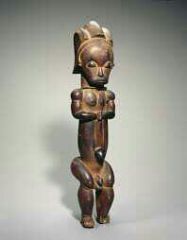
|
N. Reliquary Figure (Byeri) D. 19th to 20th Century CE P/S. 19th Century A. Fang Peoples OL. Southern Cameroon P. Family of the deceased M/T. Wood F. Ancestor veneration DT. Relic containers, stylized human figures, sit on the edge of bark boxes of ancestral bones, symmetric, proportions greatly emphasize the head, rhythmic buildup of forms suggest contained power. Severely stylized body in the form of an open lozenge below a wooden head covered with strips and sheets of polished copper and brass. Geometric ridges, borders, and subdivisions. Hairstyles were flattened out above and beside the face. C. The fang people pay respect to ancestors through material form of collections of cranial and other bones gathered in special containers. Protected by stylized human figures or in some cases simply heads. The guardian reliquaries insure that no harm befalls the ancestral figures. Gleaming surfaces are said to repel evil spirits. |
|
|
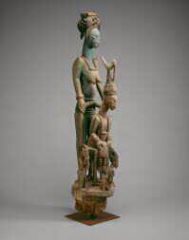
|
N. Veranda Post of Enthroned King and Senior Wife (Opo Ogoga) D. 1910-1914 CE P/S. 20th century A. Olowe of Ise (Yoruba Peoples) OL. Palace of Ikere, Africa M/T. Wood and pigment P. Opo Ogoga F. Record the legacy of the king DT. she is very wise and watches over her husband. her hands are placed on the back of his chair, their necks and bracelets mirror each other C. represents supernatural, shows king's supernatural ability to protect the community |
|

